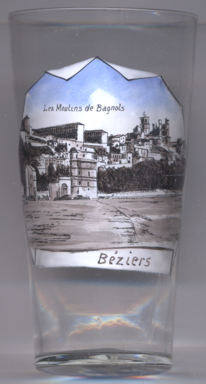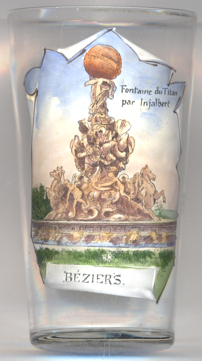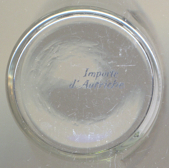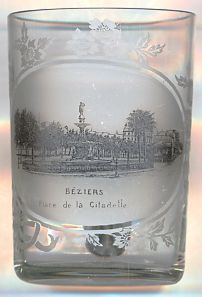

|
| FRANCE | FRANCE |
| région: Occitanie | |
| département: 34, Hérault |
Béziers (in Occitan: Besièrs) is situated at an elevation of 4–120 m on a bluf above the river Orb, about 10 km from the Mediterranean Sea in the Languedoc region in southern France. The city has a population of about 71,000 (2005) and is a sous-préfecture within the département Hérault.
The site has been occupied since Neolithic times, before the influx of Celts. Roman Beeterrae was on the road that linked Provence with Iberia. The Romans refounded the city as a new colonia for veterans in 36/35 BC and called it Colonia Julia Baeterrae Septimanorum. During the 10th through 12th centuries Béziers was the center of a viscountship; the viscounts ruled most of the coastal plain around the city, including also the city of Agde. Béziers was a Languedoc stronghold of Catharism, which the Catholic Church condemned as heretical and which Catholic forces extirpated in the Albigensian Crusade. Béziers was the first city to be sacked, on July 22, 1209. Béziers' Catholics were given the opportunity to leave before the Crusaders besieged the city. However, they refused and fought with the Cathars. In a sortie outside the walls, their combined force was defeated, and pursued back into town. In the bloody massacre which followed, no one was spared, not even those who took refuge in the churches. The invaders fired the cathedral of Saint Nazaire, which collapsed on those who had taken refuge inside. The town was pillaged, and burnt. A few parts of the Romanesque cathedral St. Nazaire survived, and repairs started in 1215. The restoration, along with that of the rest of the city, continued until the 15th century. In the repression following Louis Napoléon's coup d'état in 1851, troops fired on and killed Republican protestors in Béziers. Others were condemned to death or transported to Guyana. Today Béziers is a principal center of the Languedoc viticulture and wine-making industries.
At Béziers, the Canal du Midi, which was built in 1666–1682 and connects the Mediterranean Sea with the Atlantic, crosses the river Orb.
The Fonserannes Locks is a major piece of infrastructure on the Canal du Midi near Béziers. It consists of eight ovoid lock chambers (characteristic of the Canal du Midi)
and nine gates, which allow boats to be raised a height of 21.5 m, in a distance of 300 m.
 Today, the 8th chamber, which locks down into the Orb, is disused because ships now exit from chamber 7 to cross the river over an aqueduct.
In 1980–1983 a water slope (canal inclined plane) was built with the intention to partly replace the Fonserannes Locks; the water slope, too,
was abandoned in 2001.
Today, the 8th chamber, which locks down into the Orb, is disused because ships now exit from chamber 7 to cross the river over an aqueduct.
In 1980–1983 a water slope (canal inclined plane) was built with the intention to partly replace the Fonserannes Locks; the water slope, too,
was abandoned in 2001.
The former cathedral  Saint-Nazaire de Béziers [left, no.3002: background top right]
is located in the western part of the historic part of Béziers, high on top of a rock dominating the Orb valley.
Already in Roman times, the site was occupied by a temple dedicated to emperor Augustus and his wife Livia. A first Christian
chapel was mentioned in the 8th century, later replaced by a Romanesque church, which was destroyed on 22 July 1209 during
the Massacre at Béziers in the Albigensian Crusade. The present church was begun in the 13th century.
The mighty rectangular tower (48 m high) is topped by a turret of the 15th century and a cast-iron campanile of the 18th century.
The tower houses the second-biggest bell of the Languedoc-Roussilon (the largest is the bell of the cathedral of Montpellier).
The former cathedral was the seat of the bishops of Béziers until 1801 when the diocese was merged with the diocese of Montpellier.
Saint-Nazaire de Béziers [left, no.3002: background top right]
is located in the western part of the historic part of Béziers, high on top of a rock dominating the Orb valley.
Already in Roman times, the site was occupied by a temple dedicated to emperor Augustus and his wife Livia. A first Christian
chapel was mentioned in the 8th century, later replaced by a Romanesque church, which was destroyed on 22 July 1209 during
the Massacre at Béziers in the Albigensian Crusade. The present church was begun in the 13th century.
The mighty rectangular tower (48 m high) is topped by a turret of the 15th century and a cast-iron campanile of the 18th century.
The tower houses the second-biggest bell of the Languedoc-Roussilon (the largest is the bell of the cathedral of Montpellier).
The former cathedral was the seat of the bishops of Béziers until 1801 when the diocese was merged with the diocese of Montpellier.
The picture on glass no.3002 [left] is labeled
 Les Moulins
Les Moulins

 The
The  Fontaine du Titan [left] in Jardin des Poètes represents Atlas bearing the
weight of the world. The statue was created by the French sculptor Jean-Antoine Injalbert in 1885. The statue had already been
conceived by the artist in 1878 for the Villa Médicis in Rome. The design was rejected and
consequently the artist changed the design in 1882. The changed design was envisaged to be realised in Saint-Germain-en-Laye. In
1884 the city of Béziers expressed the wish to acquire the statue; in 1885 Béziers got the permission under condition that the
statue should form the central piece of a fountain. The work was finally unveiled in 1893. The bronze statue was requisitioned in
1942 but luckily was not melted down. After World War II the statue of Titan was reinstalled.
Fontaine du Titan [left] in Jardin des Poètes represents Atlas bearing the
weight of the world. The statue was created by the French sculptor Jean-Antoine Injalbert in 1885. The statue had already been
conceived by the artist in 1878 for the Villa Médicis in Rome. The design was rejected and
consequently the artist changed the design in 1882. The changed design was envisaged to be realised in Saint-Germain-en-Laye. In
1884 the city of Béziers expressed the wish to acquire the statue; in 1885 Béziers got the permission under condition that the
statue should form the central piece of a fountain. The work was finally unveiled in 1893. The bronze statue was requisitioned in
1942 but luckily was not melted down. After World War II the statue of Titan was reinstalled.
The picture on glass no. 2385 [below] is labeled
Place de la Citadelle. The square had originally been named Place del Castel, le Plain du Château and
then la Citadelle in 1609. It was renamed Place de l'Esplanade in 1709, during the French Revolution it was called
Place de la Fédération or Place de la Liberté. In 1807 it was renamed Place d'Armes,
in 1857 Place de la Citadelle and in 1918 Place de la Victoire.
 Today the square is called Place Jean Jaurès, named for the French Socialist politician and philosopher (1859–1914).
Jaurès was a committed antimilitarist who tried to use diplomatic means to prevent what became the First World War. He promoted
an understanding between France and Germany. As conflict became imminent, he tried to organise general strikes in France and Germany
in order to force the governments to back down and negotiate. This was difficult since many Frenchmen wanted revenge for their defeat
in the Franco-Prussian War and the return of Alsace and Lorraine. On July 31, 1914 Jaurès was assassinated in a
Paris café by Raoul Vilain, a young French nationalist. Vilain was tried after World War I and
acquitted (but was assassinated himself in 1936 at the outbreak of the Spanish Civil War by an unknown attacker).
In 1924, Jaurès’ remains were transferred to the Panthéon. Since then, many communes in France have named streets
and squares for him.
Today the square is called Place Jean Jaurès, named for the French Socialist politician and philosopher (1859–1914).
Jaurès was a committed antimilitarist who tried to use diplomatic means to prevent what became the First World War. He promoted
an understanding between France and Germany. As conflict became imminent, he tried to organise general strikes in France and Germany
in order to force the governments to back down and negotiate. This was difficult since many Frenchmen wanted revenge for their defeat
in the Franco-Prussian War and the return of Alsace and Lorraine. On July 31, 1914 Jaurès was assassinated in a
Paris café by Raoul Vilain, a young French nationalist. Vilain was tried after World War I and
acquitted (but was assassinated himself in 1936 at the outbreak of the Spanish Civil War by an unknown attacker).
In 1924, Jaurès’ remains were transferred to the Panthéon. Since then, many communes in France have named streets
and squares for him.
The fountain depicted on the glass was the
 Fontaine
Fontaine
[Texts adapted in part from http://en.wikipedia.org/wiki/Béziers, http://en.wikipedia.org/wiki/Fonserannes_Locks,
https://en.wikipedia.org/wiki/Fonserannes_water_slope;
http://www.sunnyfrance.net/histoiredebeziers/rues_UK.htm, https://de.wikipedia.org/wiki/Jean_Jaurès,
http://www.cparama.com/forum/kiosques-a-musique-t21074-140.html#p97499;
https://de.wikipedia.org/wiki/Kathedrale_von_Béziers, https://en.wikipedia.org/wiki/Béziers_Cathedral;
http://www.auxilium34.org/beacuteziers.html, http://beziers-info.com/index.php?mod=articles&ac=commentaires&id=140,
http://www.beziers-france.com/2012/09/fete-de-la-plantade.html;
http://www.nella-buscot.com/jardins_beziers_fontaine_titan.php,
http://e-monumen.net/patrimoine-monumental/fontaine-du-titan-beziers/]
![[scale]](lineal.jpg)